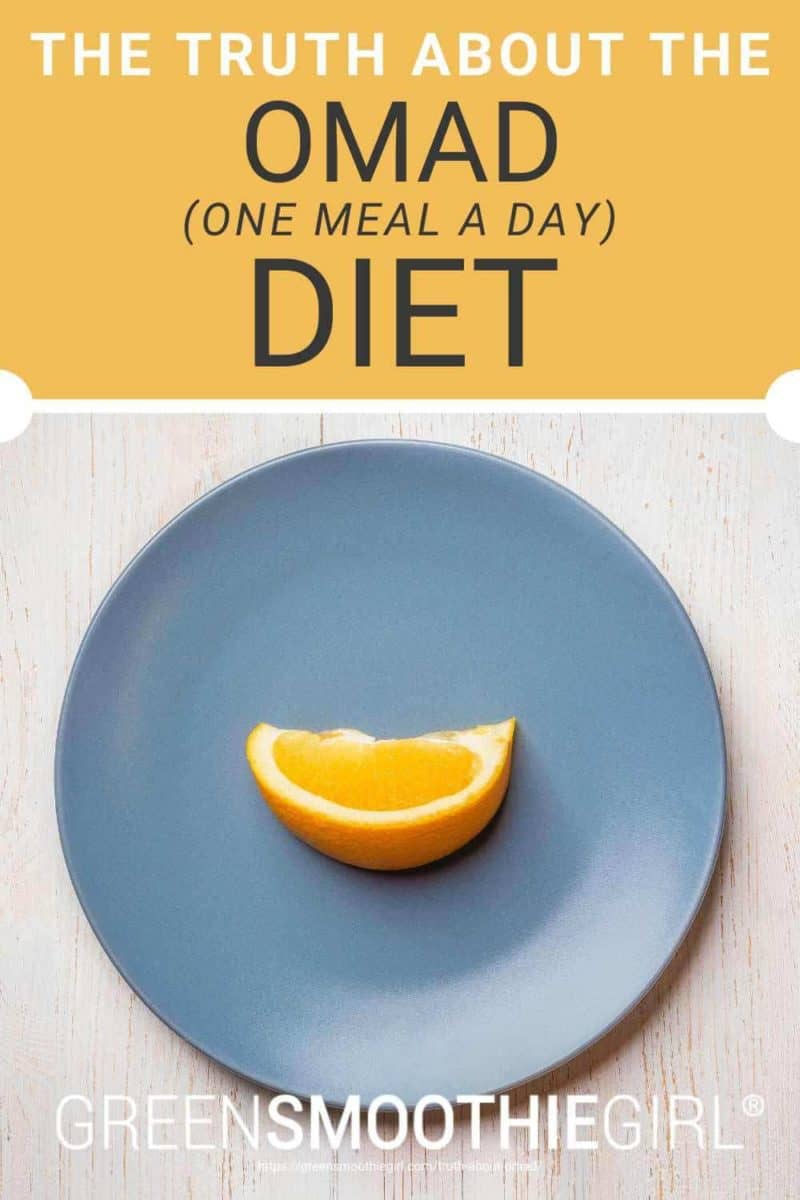The Truth About the OMAD (One Meal a Day) Diet

Fasting is having a moment.
And for good reason! In 2016, nobel-prize-winning research1 revealed how powerful fasting can be for weight loss,2 longevity,3 immune function,4 and inflammation5 (to name just a few!). Millions of people are learning what ancient cultures around the world already knew: Regular fasting is one of the very best things you can do for your health.
And now that studies show modified fasting can give the same benefits as water-only fasting,2 the “more is better” phenomenon has shown itself in the form of a new fasting trend called OMAD (one meal a day).
[Related: Will A Fasting Diet Give You The Results You Want?]
In this article:
- What is OMAD?
- Potential Benefits of OMAD
- Potential Drawbacks of OMAD
- But, Does OMAD Work?
- Modified Fasting vs. OMAD
- TLDR; The Truth About OMAD
What Is OMAD?
OMAD, or “One Meal a Day,” is an extreme form of intermittent fasting6 where dieters eat just one meal a day, restricted to a 1-hour period of time. While many experts caution against the extreme nature of the diet, followers claim some dramatic results.
The Rules of OMAD
The rules of OMAD go like this: Dieters maintain a fasted state for 23 hours each day. Only non-calorie liquids may be consumed, including tea, coffee, and water. The single meal consumed each day must be finished within a one-hour eating window, and that eating window must stay consistent within a 4-hour timeframe each day.
The meal you eat must fit on a dinner plate (no bowls allowed), and the food on that dinner plate can’t rise more than 3 inches above the surface of the plate.
Potential Benefits of OMAD
The OMAD diet has been popularized with some compelling benefits (and a lot of hype on platforms like Reddit). Take this list of benefits with a word of caution: Almost all can be gained in a more sustainable way, without the accompanying drawbacks of the OMAD diet (more on that next!).
Improved Insulin Resistance
Almost any type of fasting will help improve insulin sensitivity and reduce insulin resistance.8 And the OMAD diet is no exception. Fasting helps the cells in your body to use insulin and glycogen more effectively and efficiently, which can also lower your A1C and fasting insulin levels while allowing your blood sugar to become increasingly more stable.
Induced Autophagy
Like the benefit of insulin sensitivity, OMAD (like most types of fasting practices) induces autophagy9 in your cells and organs.
Autophagy, which means “self eating,” is triggered by food scarcity (for instance, while you sleep or during times of famine). In this process, the body recycles old and damaged cell parts, and breaks down and destroys foreign bodies like cancerous cells or bacterial or viral cells, while also flushing waste from the body.
While inducing autophagy regularly is important, the extreme OMAD diet isn’t the only way to reap these benefits, and not likely the best, either.
Can Be Effective in the Short Term for Severe Obesity
For people under a specialist’s supervision or with a lot of weight to lose (e.g., lots of fuel reserves), an extreme form of fasting like OMAD can help certain people lose weight very quickly.
However, because of the potential health complications that can arise with very rapid weight loss (gallbladder attacks, for instance), combined with the numerous health complications of obesity (like diabetes or hypertension), this approach should be medically supervised and isn’t a sustainable long-term practice.
No Calorie Restriction and Very Little Meal Prep or Planning
OMAD doesn’t require calorie counting, and hardly any meal prep or planning at all (clearly, since you’ve only got one meal per day to eat!). For some people, the idea of only planning and eating one big meal each day is appealing.
Potential Drawbacks of OMAD
Any potential benefits from OMAD are overshadowed by a long list of significant drawbacks.
At the top of the list are the diet’s diet’s extreme and sometimes arbitrary rules, which make it unsustainable. And any diet that revolves around extremes and unsustainable practices is going to end poorly.
Before you jump on board with the OMAD trend, make sure you understand all potential pitfalls:
Extreme and Unsustainable
Eating one meal per day just isn’t compatible with our basic need for regular nutrition and fuel. Long-term adherence to an OMAD diet can wreak havoc with your body’s natural hunger cues and ability to eat intuitively.
Kristen Ciccolini, holistic nutritionist and founder of Good Witch Kitchen, says, “OMAD is wildly restrictive with a number of arbitrary rules, like the idea of piling a plate up to three inches high. OMAD requires you to suppress your natural hunger and fullness cues throughout the day, which consistently takes you further away from your intuitive hunger cues and ability to trust your instincts.”

We believe a more useful set of rules would include the quality of the food on the plate. Research on modified fasting, which we believe is the easiest, most sustainable, and most evidence based way to fast, shows that plant-based whole foods are the only thing appropriate to people looking to leverage the body’s means of autophagy.
While studies have shown that fasting can generate “positive stress” (called “eustress” or “hormesis”) on your body (much like exercise does), this isn’t meant to be a constant state. Your body needs time to relax and rest from the stress of food deprivation.
Difficult to Get Enough Nutrients and Variety
According to OMAD, the type of food for the daily meal doesn’t matter that much. In reality, getting enough nutritional variety for good health in that one meal would be nearly impossible, even with a lot of planning and food prep. It can also be difficult to avoid giving into emotional eating and going for a cheeseburger, pizza, or other junk foods, since you’ve only got one meal to satisfy a craving.
With OMAD, poor food choices for even one meal would deprive your body of a whole day’s nutrition, and in the long term, the results could be disastrous. Also, if what’s on your plate is chicken wings and french fries, your body will struggle with metabolizing it, for many, many hours, making autophagy and detoxification unlikely or impossible.
Lack of Energy, Intense Hunger, Fatigue, and Cold
As your body gets worn down by a sustained state of famine, you’re likely to notice more fatigue, intense hunger as your body prompts you to eat more consumed calories regularly, and lack of energy as your system attempts to conserve its resources during a time of scarcity.
While many people who follow the OMAD diet report feelings of euphoria and high energy at times during the diet (which makes sense given the famine state; your body wants you to have bursts of energy to go hunt for food and run from predators!), that euphoria or high energy won’t last long. You may also notice feeling cold, as your body tries to cut back on body temperature to conserve energy.
Gastrointestinal Issues
Going from eating nothing to eating one large meal can wreak havoc on your digestive system as your body suddenly scrambles to kick into gear. Diarrhea, cramping, and nausea can all result if you overdo it with that one opportunity to eat during the day. And with just one shot at a meal, it’s easy to overdo it often.
Incompatible with Real Life
Let’s get real for a second: eating one meal per day is tough when it comes to living and working with other people. Between work lunches, gatherings with friends, meals with family, and on and on, food is part of our social lives in countless ways.
A diet that is constantly incompatible with real life and social gatherings is another strike against sustainability.

Can Be Triggering for Disordered Eating and Binge Eating
The extreme OMAD diet also carries a high risk for binge eating and disordered eating.
“Consistent food restriction carries the risk of being a gateway to disordered eating habits.” Ciccolini says. “The body can handle short periods of famine; that's how our ancestors survived. But over-restriction can lead to binge-eating, low energy, and fatigue as the body becomes desperate for energy in any form possible, in as large a quantity as possible.”
Potential Drawbacks for Fertility
Some research also warns that extreme forms of intermittent fasting might also affect fertility.10 In women, the pituitary gland in most mammals (including humans!) closely monitors conditions of food scarcity and abundance.
For the best chance of survival for our offspring, our bodies want us to bear young during times of plenty. By constantly restricting food in an extreme way, you may run the risk of significantly reducing or even eliminating ovulation.
Discourages Mindful Eating
When you eat just ONE meal a day, it’s difficult to truly be mindful of hunger cues and to allow your body’s brilliant system of hormones, that encourage you to eat (and stop eating) at intervals during the day, to work properly. These signals are meant to provide your body with fuel, antioxidants, and nutrients when they are needed.
While regular, short fasts can help restore balance to those very hormones that help you eat mindfully (like leptin, ghrelin, etc.), fasting 23 hours every day isn’t the solution, and can actually make it more difficult for your body’s endocrine system to signal fullness and hunger appropriately.
But, Does OMAD Work?
The truth is that OMAD can lead to weight loss. But then again, so can an eating disorder.
In other words, OMAD will work. Depending on the outcome you want, even fad diets can “work” as long as you continue the diet. But the more important question is: will you be healthier for doing it? The answer, according to the overwhelming number of experts, is no.
My perspective has always been: if it’s not sustainable in the long run, it doesn’t truly work.
Modified Fasting vs. OMAD
Think of different fasting practices as a continuum. The truth is, unless you eat all day and all night, each of us fasts a certain amount of time on a daily basis.
On one end of the fasting continuum, you have the extreme of OMAD (right next to disordered eating and starvation diets). And on the other end of that continuum, you have individuals (the majority of Americans!) who truly fast only during the hours spent sleeping.
Modified fasting is the Goldilocks of the fasting continuum. It combines all the health benefits of regular, intentional fasting (including autophagy, weight loss, and insulin sensitivity!) with a sustainable, simple, flexible approach.
It’s safe and effective enough to be used quite often for individuals with a lot of weight to lose (as often as once per week). And it’s powerful enough that a modified fast of even once per quarter offers incredible health benefits.
And the best part? With a 3-day modified fast, you still get to eat five evenly-spaced mini-meals each day, totaling 650-800 calories.

TLDR: The Truth About OMAD
The experts (and common sense!) are in alignment on this one: While fasting offers incredible health benefits when done in moderation, OMAD is simply too extreme and unsustainable.
While it’s possible to lose some weight and lower your insulin resistance with OMAD, the extreme nature of the diet carries some hefty risks including disordered or binge eating, fertility problems, nutritional deficiencies, fatigue and extreme hunger, and gastrointestinal issues.
Thankfully, OMAD isn’t the only method of fasting that can help you lose weight, improve your insulin sensitivity, and induce autophagy. Modified fasting, a sustainable and simple alternative to OMAD, is one of the best things you can do for your health.

Disclosure: This post may contain affiliate links that help support the GSG mission without costing you extra. I recommend only companies and products that I use myself.

Resources
- Levine B, Klionsky DJ. Autophagy wins the 2016 Nobel Prize in Physiology or Medicine: Breakthroughs in baker's yeast fuel advances in biomedical research. Proc Natl Acad Sci U S A. 2017;114(2):201–205. doi:10.1073/pnas.1619876114
- Ganesan K, Habboush Y, Sultan S. Intermittent Fasting: The Choice for a Healthier Lifestyle. Cureus. 2018;10(7):e2947. Published 2018 Jul 9. doi:10.7759/cureus.2947
- Heilbronn L.K., de J.L., Frisard M.I., DeLany J.P., Larson-Meyer D.E., Rood J., Nguyen T., Martin C.K., Volaufova J., Most M.M., et al. Effect of 6-month calorie restriction on biomarkers of longevity, metabolic adaptation, and oxidative stress in overweight individuals: A randomized controlled trial. JAMA. 2006;295:1539–1548. doi: 10.1001/jama.295.13.1539.
- Mohapatra, Sipra, et. al. “Short-term starvation and realimentation helps stave off Edwardsiella tarda infection in red sea bream (Pagrus major).” Comparative Biochemistry and Physiology Part B: Biochemistry and Molecular Biology. Volume 206, April 2017, pages 42-53.
- Jordan, Stefan. Dietary Intake Regulates the Circulating Inflammatory Monocyte Pool. (2019). Cell.
- Baum, Isadora. “Everything You Need to Know About This Extreme Intermittent Fasting Weight-Loss Plan.” Health.com, January 8, 2019.
- Pawloski, A. “What is the OMAD diet? Learn how the one-meal-a-day diet works.” Today.com, January 3, 2019.
- Arnason TG, Bowen MW, Mansell KD. Effects of intermittent fasting on health markers in those with type 2 diabetes: A pilot study. World J Diabetes. 2017;8(4):154–164. doi:10.4239/wjd.v8.i4.154
- Anton SD, Moehl K, Donahoo WT, et al. Flipping the Metabolic Switch: Understanding and Applying the Health Benefits of Fasting. Obesity (Silver Spring). 2018;26(2):254–268. doi:10.1002/oby.22065
- Fontana R , Della Torre S . The deep correlation between energy metabolism and reproduction: a view on the effects of nutrition for women fertility. Nutrients. 2016;8(2):87.














